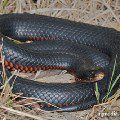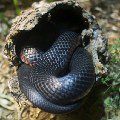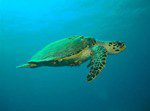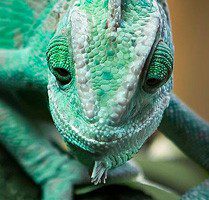
Echidna black
ECHIDNA BLACK (Pseudechis porphyriacus) or black snake, distributed throughout Eastern and Southern Australia, reaches a length of 1,5-2 m. The brilliant black color of the upper side of the body is effectively combined with the reddish color of the belly. The black snake keeps in moderately humid low-lying places and along river valleys, willingly goes into the water, swims and dives well. It feeds on frogs, lizards, snakes. Juveniles prefer insects and other invertebrates. In captivity, the black snake eats mice well.
Contents
Classification
Kingdom: Animalia (animals)
Type: Chordata
Class: Reptilia (reptiles)
Order: Squamata (scaly)
Suborder: Serpentes (snakes)
Family: Elipidae (aspididae)
Genus: Pseudechis (echidnas)
Species: Pseudechis porphyriacus (black echidna)
Inhabitation
 It lives throughout Australia, more in its southern and eastern parts, as well as on the islands of New Guinea, with the exception of Tasmania and the north of the country. Prefers to settle near water spaces, but can also live in damp lowlands. Favorite habitats are swamps and rivers. The black echidna is an excellent swimmer and diver, which can spend a long time (up to 1 hour) under water without additional inhalation of air. It develops the greatest activity during the daytime, when the water warms up well.
It lives throughout Australia, more in its southern and eastern parts, as well as on the islands of New Guinea, with the exception of Tasmania and the north of the country. Prefers to settle near water spaces, but can also live in damp lowlands. Favorite habitats are swamps and rivers. The black echidna is an excellent swimmer and diver, which can spend a long time (up to 1 hour) under water without additional inhalation of air. It develops the greatest activity during the daytime, when the water warms up well.
Description
 The black echidna is the largest of the poisonous snakes in the world, as well as one of the most poisonous snakes in the tropical zone and is rightfully included in the list of the seven most dangerous snakes on the planet. In Australia, the black echidna is simply called “black snake” by locals.
The black echidna is the largest of the poisonous snakes in the world, as well as one of the most poisonous snakes in the tropical zone and is rightfully included in the list of the seven most dangerous snakes on the planet. In Australia, the black echidna is simply called “black snake” by locals.
Until the middle of the 19th century, a variety of poisonous snakes, including an ordinary viper, were often mistakenly called echidna. In length, it reaches an average of 1 – 5 meters, however, individuals about three meters long have been recorded.
The body and head of the black snake are painted from above with a brilliant, bluish-black color. The underside is pink to bright red with a black border. The scales of this species are smooth and symmetrical. Her body is thin, her head is small, narrow, covered with rare brown spots, which are located near the eyes and on the nose of the snake.
Paired poisonous teeth are located in front of the shortened maxillary bones; they are noticeably larger than the rest of the teeth, bent back and equipped with a poisonous canal; fixed motionless (primitive feature). The venom-conducting canal in asps originated from a groove on the front surface of the tooth by gradually closing its edges. Usually only one of the poisonous teeth functions, the second is a “substitute” in case of loss of the first. In addition to fangs, the upper jaw has small teeth.
If danger is suspected, the snake stretches its neck above the ground to a height of 10-20 cm, tilts the front of the body and at this time inflicts a bite. Her bite can be potentially fatal to humans, she is almost the champion in the amount of poison released and produced. The neurotoxic poison secreted by it is capable of causing the coagulation of proteins in the body. The black echidna is especially dangerous for swimmers because of its manner of lying motionless at the bottom of the river without showing signs of life. However, she attacks only if she is stepped on, shows open aggression or tries to catch her. Deaths due to the bite of this snake are quite rare, despite the fact that in Australia there are many more people bitten by this particular snake than bitten by other snakes. The fact is that its poison, although produced in large quantities, does not have a strong effect, due to the fact that in the case of defense, the snake releases a smaller amount of poison than when hunting.
Food
The main diet of the black echidna is made up of small vertebrates, mainly frogs.
Young individuals of this species prefer to eat insects and other invertebrates, reptiles and small mammals. They may also eat snakes, including those of their own kind. After the artificial introduction of aga toads covered with poisonous mucus into the ecosystem, a significant part of the population died. However, recently, there has been a significant increase in the number of these snakes. This happened due to the fact that black echidnas changed their priorities in nutrition and began to give preference to rodents in nutrition. In captivity, the black echidna also readily feeds on mice.
Reproduction
During the mating season, the males of this species enter into tournament fights among themselves for the female. They step on each other with their necks arched and their heads raised, trying to cover the opponent’s head with their head. When one of them succeeds, he wraps his body around the opponent’s torso with a sharp movement. Furiously wriggling and hissing, they squeeze each other. After a while, as if on cue, they stop fighting and crawl away to prepare for the next stage of the struggle. Each of these “stages” lasts about a minute, and they are repeated until the males are completely exhausted. They are so engrossed in the tournament that they may not unravel even if they are lifted from the ground. Tellingly, during the horizontal bar, the snakes do not bite each other.
In addition to sexual arousal, the territorial instinct also serves as the cause of such fights.
The black echidna belongs to the so-called ovoviviparous snakes, like other asps. This means that she gives birth to already formed and viable cubs. Most often, as in the case of the black echidna, live birth is simply the result of the retention of eggs in the female’s oviducts. Those. eggs do not develop in the ground, not in moss, not in a pile of dry leaves, as in most snakes, but in the body of the mother. At the same time, a dense network of blood vessels develops in the snake’s oviducts and oxygen from the mother’s blood seeps into the egg, providing breathing for the baby. He gets his food from the egg yolk. Zoologists call this phenomenon the somewhat clumsy word “ovoviviparity”.
The snakes that managed to master live birth received a lot of advantages compared to other representatives of their suborder. First of all, their eggs are constantly under reliable protection. At the same time, the mother can calmly hunt, and not sit at the nest, as if tied, like a king cobra, which inseparably guards the eggs. In addition, the snake can choose the most suitable places at any given time – well-warmed, which is especially important in the north, or cool, which is very important in tropical deserts. It is very difficult to find a place where favorable conditions would be constantly preserved for a long time.
The size of the cubs is on average about 15 – 22 cm in length. The female can give birth to 8 to 40 cubs, however, due to the high mortality rate, few survive to adulthood. The first molt occurs 10-11 days after birth.
Additionally
Black echidna venom does not have a significant effect on the walls of blood vessels and platelets, therefore, coagulopathy in clinical practice in case of poisoning with poisons from Australian asps does not pose a particularly serious problem, although, in rare cases, the possibility of intracerebral hemorrhages exists and can cause death. Of the representatives of this group, the venom of this snake has the strongest hemolytic effect.
The poison in its general toxic effect resembles the action of the poisons of sea snakes and kraits, but differs greatly from them in its composition.
The action of presynaptic toxins is associated with phospholipase activity. Presynaptic polypeptides have a slower mechanism of action, but are more toxic than postsynaptic polypeptides. The use of whey better inhibits the action of postsynaptic toxins. In case of poisoning with poisons containing strong presynaptic toxins, the use of serum practically does not slow down the development of paralytic symptoms, especially with delayed administration.
After a bite, moderate local pain is felt at the site of the introduction of the poison and in the region of regional lymph nodes, and slight swelling is observed. As a rule, there is a headache, vomiting occurs (sometimes with an admixture of blood). Within an hour, neurological symptoms develop: darkening of the eyes, drowsiness, respiratory depression, diarrhea mixed with blood, hematuria. There were no signs of paralysis or significant coagulation disorders.
The black echidna differs from other representatives of the genus Pseudechis in some details of the general morphology, the structure of the venom and blood proteins, and pholidosis. In addition, it is the only viviparous species in this genus of snakes.
Serums Notechis and Pseudechis are used to neutralize its venom. In neutralizing the venom, Notechis serum is more effective than the polyvalent Pseudechis serum, since the latter has a weaker effect and requires a larger injection volume.
The black echidna is one of the seven most dangerous snakes on the planet.
Until the middle of the 19th century, a variety of poisonous snakes, including an ordinary viper, were often called echidna.
Sources of
http://crenature.ru
http://ours-nature.ru
http://www.floranimal.ru
http://www.mad-love.ru
http://army.lv/ru
http://neobychno.com
http://www.zooznaika.r
Content in captivity
Keeping this species in an artificial environment requires great care, given the poisonousness of the snake.
To create favorable conditions, they need a terrarium with a temperature of 22 – 28 degrees with shelters such as grottoes or wooden houses that create a darkened area and bedding of large chips. To maintain the required air humidity, it is necessary to spray water inside the terrarium 2-3 times a week. For feeding adults, rats aged approximately 7-9 days and laboratory mice are used. When feeding frogs, it is necessary to pay special attention to the place of capture, species and their general condition, because snakes are very sensitive to toxins that frogs can be poisoned with (in particular, drugs to kill mosquitoes, which are treated in many reservoirs). After the first molt, kites, as a rule, can already feed on their own. They are fed 2 – 3 day old laboratory mice, gradually increasing the age of mice intended for food.





